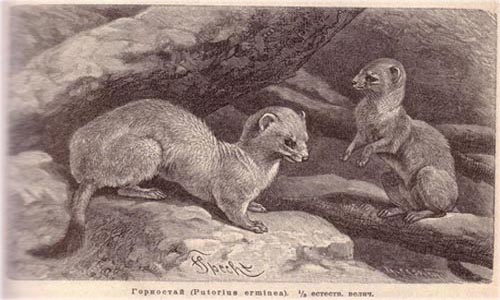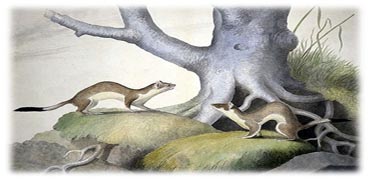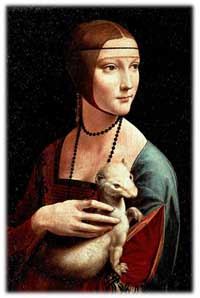[wp_ad_camp_1]
aka … short-tailed weasel, Bonaparte weasel
A male stoat is called a ‘dog’, ‘hob’, or ‘jack’, while a female is called a ‘bitch’ or ‘jill’. The collective noun for stoats is either ‘gang’ or ‘pack’.

stoat c.1460, stote “ermine in its summer coat of brown,” of uncertain origin. The word bears resemblance to O.N. stutr “bull,” Swed. stut “bull,” Dan. stud “ox,” but the sense is difficult unless a common notion is “male animal.”
ermine c.1175, from O.Fr. hermine, both the animal and the fur, apparently from a convergence of L. (mus) Armenius “Armenian (mouse),” ermines being abundant in Asia Minor; and an unrelated Gmc. word for “weasel” (cf. O.H.G. harmo “ermine, stoat, weasel,” adj. harmin; O.Saxon harmo, O.E. hearma, etc.) that happened to sound like it.
Appearance
The stoat is brown and white, looking very much like the least weasel, except that it has a black tip to its tail. The ermine is completely white in winter, a bit like the least weasel, apart from that black tip on its tail.
David Macdonald, who wrote about mustelids in his book “The Velvet Claw, A Natural History of the Carnivores” has this to say about the stoat/ermine’s appearance …
Northern weasels molt into white winter coats, while those to the south remain dark brown all year. Along the border of this change, it has been found that stoats’ pelts change color in response to temperatures. For example, the stoat’s flanks and rump will change to white at 36 degrees, while the head and back don’t change until the temperature reaches 30 degrees.
In the field, this means the stoat changes to the white form (then known as ermine) when snow covers the ground for at least 40 days. At that threshold, “piebald” stoats are common.

Size
The size of the stoat/ermine varies geographically and also between sex. Stoats are smaller in northern than in central Europe.
Males: lengths range between 275-312mm; weight between 200-445g.
Females: lengths range between 242-292mm; weight between 140-280g.
They are larger in North America.
Breeding
Stoats/ermines have delayed implantation, which means they mate in the summer but the embryos stay dormant in the uterus after they’ve been fertilized. Then, about 3-4 weeks before birth, the embryos develop and are ready to be born the following spring or early summer.
The total post-fertilization gestation period of stoats/ermines is between 200-340 days.
Only one litter of 5-12 kits is produced a year. When the kits are born, they’re covered with fine white hair and around the 3rd week, they develop a dark mane of fur around their necks.

During the breeding season a lactating female requires 100% of her body weight in food each day and the mother will be extremely fierce in defending her kits.
Young stoats develop rapidly and are able to hunt for themselves at about 11 weeks old. Even after the young have left, the family still stays together to hunt and play!
Males will sometimes mate with young female kits in the nest, so that they are pregnant before they even leave their mothers.[wp_ad_camp_2]
Diet
The stoat/ermine feeds mainly on mice, shrews, voles, rabbits, rats, birds and small fish, birds’ eggs, berries and insects.
New Zealand found that the stoats introduced into that country to control rabbits were decimating the kiwi chicks so they are now being trapped and destroyed, together with weasels (also introduced by English settlers) and ferrets (which were released in the wild by stupid breeders).
Stoats have been known to do silly things as part of their hunting strategy. They’ll approach a group of rabbits and break out into a weasel wardance, jumping and twisting and turning their bodies. The rabbits stop to watch this weird performance and the stoat suddenly jumps on the nearest rabbit and says, “Gotcha!”
I’ve heard a thought that the weasel’s wardance is due to nematodes, parasitic worms, which lives in the stoat’s sinus cavity and cause the poor animal to twist and turn not because it’s doing its weasel wardance but because it’s in absolute agony as these worms invade its brain.

Up to 10 years, according to the BBC Science website. I wonder why they live so much longer than the least weasel, which they’re often mistaken for.
Another website claims that ermines have lived up to 7 years in the wild but the average lifespan is 1-2 years.
Distribution & Habitat

They are considered to be the most widespread mustelid and can be found across northern Europe, the UK, Canada, northern USA and Eurasia.
Stoats/ermines are found in moorlands, marshes near woods, lowland farms, shorelines or mountains.
Conservation Status
The stoat/ermine is considered Lower Risk Least Concern on the IUCN Red List of Threatened Species website (wef Dec 2015)
Famous Ermines
There are two famous paintings with ermines featured.
Queen Elizabeth I with an ermine
Nicholas Hilliard painted a picture of Queen Elizabeth I in 1585 and had an ermine resting on her arm.

He also invented special techniques for painting jewels.
He’d put a raised drop of white paint on his pearls with some shadowing to one side, then topped it with a bit of real silver which was then burnished “with a pretty little tooth of some ferret or stoat or other wild little beast”, as recorded in his own treatise.
Why did he include an ermine?
The ermine was prized for its tail, which was pure white with a black tip. According to legend, the ermine would rather die than soil its pure white coat so it came to stand for purity. And as wearing ermine was restricted to royalty and high nobility, it also came to be seen as a status symbol.
Leonardo’s ‘Lady with Ermine’
This picture is hanging in the museum in Krakow and was bought by Prince Adam Jerzy Czartoryski in Italy, He added it to the Czartoryskis’ family collection in 1800.

It has been suggested that the model who posed for the picture was Cecilia Gallerani, mistress of Ludovico Sforza (the Duke of Milan).
According to this website “The delicate little animal has been identified as an ermine in its winter coat; according to legend these animals died if their white coats became dirty. These animals were considered to be a symbol of chastity from as early as the third century after Christ; its use here is somewhat ironic considering that in this period a woman was required to be chaste, but also a most devoted mistress.
The presence of the ermine also injects a subtle touch of humour to the portrait since its Greek name of galee offered a pun on her own name. Leonardo reproduced an amazingly wide variety of animals in his work and said of the ermine that it ‘does not eat other than once a day, and it will rather be taken by hunters than escape into a dirty lair.‘”
I don’t know about you but I think that ermine is most un-ermine looking! They’re small little animals but the one Leonardo painted seems huge and so muscular! Weird!
Stoat/Ermine Trivia
Britain has been using stoat hair for fly-tying for many years. Apparently the wing of salmon flies uses the black hairs from the end of the stoat’s tail. This pattern has a black body with a silver rib.
Other patterns include the thunder stoat, as well as the silver or gold stoat’s tail.
[wp_ad_camp_3]
How to say Stoat/Ermine in Different Languages
- Albanian: hermelinë
- Arabic: قاقم حيوان, فرو القاقم
- Bulgarian: хермелин
- Chinese: 鼬
- Croatian: hermelin
- Czech: lasice hranostaj, hermelín
- Danish: lækat, hermelin
- Dutch: hermelijn
- Esperanto: ermeno
- Finnish: kärppä, kärpännahka
- French: hermine
- Fresian [spoken in Friesland]: harmeling
- German: Hermelin
- Greek: ερμίνα
- Hebrew: סמור (מסוג מסויים)
- Hungarian: hermelin
- Indonesian: cerpelai
- Irish (Gaeilge): neas mhòr
- Italian: ermellino
- Japanese: オコジョ
- Korean: 흰담비
- Latvian: sermulis
- Lithuanian: šermuonėlis
- Norwegian: røyskatt
- Persian [Farsi]: قاقم )ج.ش.(, خز قاقم
- Polish: gronostaj
- Portuguese: arminho
- Romanian: hermină
- Russian: горностай
- Serbian: hermelin
- Slovak: hermelín, hranostaj
- Spanish: armiño
- Swedish: hermelin, vessla
- Tagalog [Philippines]: puting wisel
- Thai: สัตว์คล้ายแมว
- Turkish: kakım
- Ukrainian: горностай
- Vietnamese: chức vị quan tòa, tước vị quan tòa
Here are some interesting links to sites about Ermines and Stoats if you’d like to read more about these fascinating animals …
 The Ermine — William Smellie’s 1781 English translation of Georges-Louis Leclerc, Comte de Buffon’s Histoire Naturelle. To download the pdf, please click HERE.
The Ermine — William Smellie’s 1781 English translation of Georges-Louis Leclerc, Comte de Buffon’s Histoire Naturelle. To download the pdf, please click HERE.
 How Arctic Animals Turn White (Old and Sold)
How Arctic Animals Turn White (Old and Sold)
 In Search of the Stoat – Mysterious Creature of Myth and Legend (The Northern Echo)
In Search of the Stoat – Mysterious Creature of Myth and Legend (The Northern Echo)
 What’s the Difference Between a Stoat and a Weasel? (How Stuff Works)
What’s the Difference Between a Stoat and a Weasel? (How Stuff Works)
If you live in the UK and you find a stranded or injured stoat (or ermine), you can contact Mustelid Rescue UK for help.
Videos of ermines …
Return from Stoat / Ermine (Mustela erminea) to All About Ferrets

Good day, I am interested in a few matting pairs for screw control in my apple orchards. Can you lead me to a Ermine breeder
Hi Stephen
I’m sorry but I have no information about ermine breeders 🙁
I’d suggest you Google the question and see if you can find someone near to where you live.
Cheers
~Nona